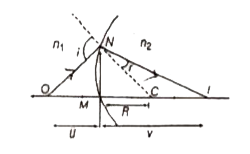Numerical aperture of an optical fibre (w.r.t air) having core and cladding refractive indices n1andn2 respectively is
√n21−n22
sin−1√n21−n22
cos−1√n21−n22
tan−1√n21−n22
The correct Answer is:A
To find the numerical aperture (NA) of an optical fiber with core refractive index n1 and cladding refractive index n2, we can follow these steps:
1. Understanding the Concept:
The numerical aperture is a measure of the light-gathering ability of the optical fiber. It is defined in terms of the refractive indices of the core and cladding.
2. Using Snell's Law:
According to Snell's Law, when light travels from one medium to another, the relationship between the angles of incidence and refraction is given by:
n1sinI=n2sinR
where I is the angle of incidence and R is the angle of refraction.
3. Critical Angle:
The critical angle θC occurs when light travels from the core to the cladding and is refracted at 90∘. At this point:
n1sinImax=n2sin90∘
This simplifies to:
n1sinImax=n2
Therefore, we can express sinImax as:
sinImax=n2n1
4. Finding the Numerical Aperture:
The numerical aperture (NA) is defined as:
NA=n1sinImax
Substituting sinImax into this equation gives:
NA=n1(n2n1)=√n21−n22
5. Final Expression:
Therefore, the numerical aperture of the optical fiber is given by:
NA=√n21−n22
Final Answer:
The numerical aperture of an optical fiber with core refractive index n1 and cladding refractive index n2 is:
NA=√n21−n22
The numerical aperture is a measure of the light-gathering ability of the optical fiber. It is defined in terms of the refractive indices of the core and cladding.
According to Snell's Law, when light travels from one medium to another, the relationship between the angles of incidence and refraction is given by:
n1sinI=n2sinR
where I is the angle of incidence and R is the angle of refraction.
The critical angle θC occurs when light travels from the core to the cladding and is refracted at 90∘. At this point:
n1sinImax=n2sin90∘
This simplifies to:
n1sinImax=n2
Therefore, we can express sinImax as:
sinImax=n2n1
The numerical aperture (NA) is defined as:
NA=n1sinImax
Substituting sinImax into this equation gives:
NA=n1(n2n1)=√n21−n22
Therefore, the numerical aperture of the optical fiber is given by:
NA=√n21−n22
The numerical aperture of an optical fiber with core refractive index n1 and cladding refractive index n2 is:
NA=√n21−n22
Similar Questions
What should be the maximum acceptance angle at the aircore interface of an optical fibre if 1 n and 2 n are the refractive indices of the core and the cladding, respectively
View SolutionA point object 'O' on the principal axis of a spherical surface of radius of curvature 'R' separating two media of refractive indices n1andn2 forms an image 'I' as shown in the figure below. Prove that n2v−n1v=n2−n1R

View Solution
Knowledge Check
In an optical fibre ,the refractive indices of the core and the cladding are given by n1 and n2 respectively . Light can travel through the optical fibre if
An1=n2Bn1<n2Cn1>n2Dn1=n23A hollow double concave lens is made of very thin transparent material. It can be filled with air or either of two liquids L1 or L2 having refractive indices n1 and n2, respectively (n2>n1>1). The lens will diverge parallel beam of light if it is filles with
Aair and placed in airBair and immersed in L1CL1 and immersed in L2DL2 and immersed in L1If refractive index of core & cladding are μ1 & μ2 respectively then :
Aμ1>μ2Bμ2>μ1Cμ1=μ2DNone of these
A biconvex lens made of material with refractive index n2. The radii of curvatures of its left surface and right surface are R1 and R2. The media on its left and right have refreactive indices n1 and n3 respectively. The first and second focal lengths of the lens are respectively f1 and f2.
Assume that R1=R2,n1≠n3. The ratio, f1/f2, of the two focal lengths is equal to
View SolutionA biconvex lens made of material with refractive index n2. The radii of curvatures of its left surface and right surface are R1 and R2. The media on its left and right have refreactive indices n1 and n3 respectively. The first and second focal lengths of the lens are respectively f1 and f2.
Assume that n1=n3. Which of the following statements is not correct ?
View SolutionA biconvex lens made of material with refractive index n2. The radii of curvatures of its left surface and right surface are R1 and R2. The media on its left and right have refreactive indices n1 and n3 respectively. The first and second focal lengths of the lens are respectively f1 and f2.
The ratio, f1/f2, of the two focal lengths is equal to
View SolutionWhat should be the maximum acceptance angle at the air–core interface of an optical fibre if n1 and n2 are the refractive indices of the core and the cladding, respectively
View SolutionIf refractive index of core & cladding are μ1&μ2 respectively then :
View Solution
